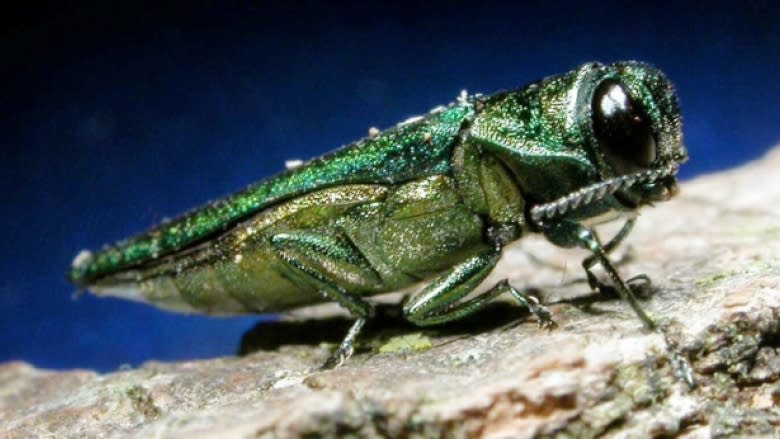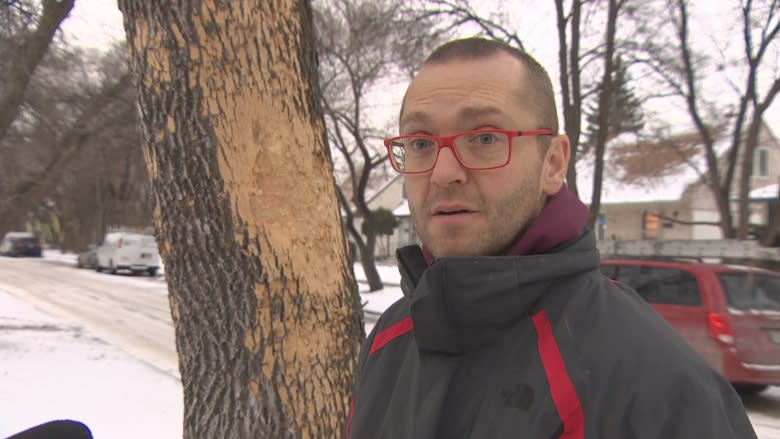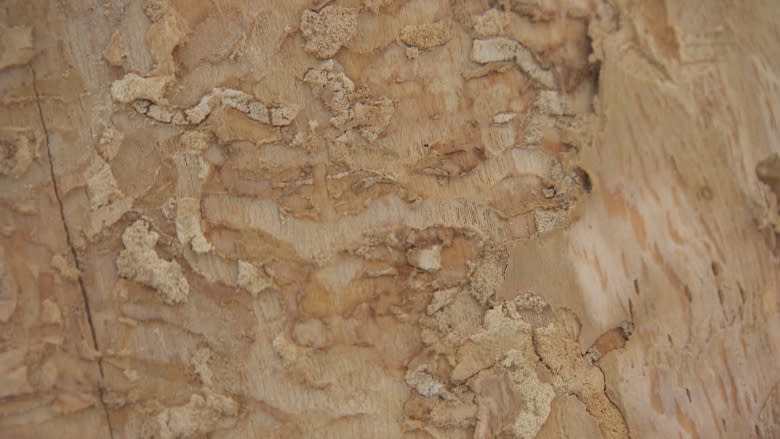Kiss your ash goodbye: Costly beetle invasion will be quick and painful for Winnipeg, scientists say
The invasive emerald ash borer beetle has devastated urban tree canopies and strained municipal budgets wherever it has touched down. Winnipeg has been bracing for its unwelcome arrival and the day of reckoning is finally here.
The Canadian Food Inspection Agency confirms as much — a suspect ash tree on Dan Law's St. Boniface boulevard was sampled and showed signs of borer beetle larvae inside.
Emerald ash borers were first detected in Detroit and Windsor, Ont., in 2002, but they had been in North America under the radar since the early 1990s. They spread through surrounding areas, eventually turning up in London, Ont. (2006), Toronto (2007) Montreal (2011) and Quebec City (2017).
They arrived in Winnipeg more quickly than federal researchers expected, and it's possible borers have been right under Winnipeggers' noses for two to four years, said Dan McKenney.
"It will take a few years before the effects are noticed, but then it really ramps up really quickly," said McKenney, senior scientist with Natural Resources Canada's forest service in Sault Ste. Marie, Ont.
"It's kind of flabbergasting how it seems to be slow … and then it just hits with a vengeance."
"Here in Ste. Marie it's pretty much come and gone in eight years," said John H. Pedlar, McKenney's colleague and a forest biologist at the Great Lakes Forestry Centre, on Friday.
Whereas Winnipeg's prolonged and costly battle with Dutch elm disease is likely to continue for years to come, McKenney said Winnipeg can kiss its ash trees goodbye, likely within the next decade.
Natural Resources Canada states on its website that typically, 99 per cent of ash trees in infected areas die within six years.
Just how significant is this little pest?
City of Winnipeg forester Martha Barwinsky says Winnipeg is at risk of losing all of its green ash trees — 350,000, give or take — in the next decade. The species makes up 30 per cent of all of city park and boulevard trees, which are valued at nearly $440 million.
The "value" likely includes various factors like cost of replacement, shade and heat benefits, rainwater run-off prevention, aesthetics and property values, said Krista Ryall, a scientist with Natural Resources Canada's forest service who has been studying borers for a decade.
"It's a major financial implication to the municipalities trying to cope with this … it's devastating," said Ryall,
She said the cost of managing the beetle has ranged from $3 billion to $10 billion US over the course of invasions across several American cities.
"One year things can look fine and by the end of that same season you can have all these dead and dying trees."
The 2,000 dots on the map below are a random sample of Winnipeg's green ash trees, the second-most common tree in the city. The data reveals although the tree was widely planted across the city, there are high concentrations in newer neighbourhoods, which experts say are likely to become the problem areas with the appearance of the emerald ash borer in Winnipeg.
View the map on mobile here.
McKenney and Pedlar published a paper in 2012 that estimated when the insect would reach Winnipeg and suggested it could cost about $200 million just to remove infected trees from streetsides — an estimate they still believe is conservative.
"Our spread modelling suggested it would be between 10 and 20 years before it arrived in Winnipeg," Pedlar said.
McKenney said it could be that spreads in the United States helped the beetle reach Winnipeg quicker than expected.
Winnipeg was put on notice last year when the bug burst onto the Thunder Bay scene, less than 700 kilometres east of Winnipeg.
One thing working against the city is that Winnipeg has a much higher percentage of ash trees than most places out east, McKenney said.
On the other hand, the Prairie city has the benefit of knowing how Ontario cities reacted — or didn't — in those early years.
"We knew nothing at the time, so they had no tools and no options, really, to work with," said Ryall.
As Canada's patient zero, Windsor learned this lesson first. It would be tempting to imagine the beetles would move out of town after reducing the majority of ash trees to sawdust, but in Windsor, even the tiny ash saplings were eaten and the pest remained planted in the Ontario border city, Ryall said.
Winnipeg strategy
Ryall is leading a project with the City of Winnipeg on how to stem the spread and plans to visit in early 2018 to get a sense of how widespread the invasion is.
The Canadian Food Inspection Agency, which monitors emerald ash borer populations in Canada and regulates efforts to prevent the spread of the pest, will conduct the first phase of visual surveys in St. Boniface and the surrounding area in the next two months or so, Ryall said.
An ash tree can harbour borers for several years and present no obvious signs of infection, so crews will use a pruning system Ryall devised that allows foresters to peel bark back and see the "galleries" of tunnels carved out in the wood beneath the surface.
"There's lots of trees that may be infested and not showing any symptoms," Ryall said, adding the bark-peeling campaign will likely start early in 2018. "This will occupy them for quite a few years to come."
Those initial results will inform the city's strategy, she said, which may eventually include the mass release of a parasitic Chinese wasp species. The wasps evolved alongside borers and hunt down their larvae (don't worry, they don't bite people), and Ryall already led such an experiment in Quebec and Ontario last year.
A facility in Brighton, Mich., breeds and sells the wasps, and Ryall is now raising her own winged legion in Sault Ste. Marie.
Though the wasps hold promise, they work best in heavily forested, rather than urban areas that don't experience the same frigid winters as does Winnipeg. It's unclear whether they'll thrive in a colder climate, Ryall said.
Winnipeg is home to several species of woodpeckers, and researchers have noted the long-billed birds have developed a taste for the borers in parts of the U.S.
Scientists have also found a way to coax beetles out into the open using pheromones produced by female borers, but that isn't yet being done on a large scale.
TreeAzin 'vaccine'
There's also now a vaccine-like injectable called TreeAzin that is commercially available in some parts of Canada that can be shot into specific "high-value" ash trees.
All of these tactics are constrained by city budgets and time.
"Unfortunately it is fairly expensive," said Pedlar.
He says the cost of inoculating an average-sized ash tree is roughly $165. Each tree has to be injected about every two years, said McKenney, and that process has to go on indefinitely. That adds up for homeowners interested in saving trees on their private property, and the price for a treatment could rise with demand.
"That's why it's a dilemma," McKenney said. "It's a serious situation."
The trick to stemming the spread will be to identify and destroy big infected trees.
City forestry workers are already facing a backlog of Dutch elm disease-infected trees identified a couple years ago which are still in the ground, contributing to the spread of that disease.
Ryall said minor landscaping duties have fallen by the wayside in other municipalities consumed with fighting borers.
Managing expectations
Ultimately this issue is as much about managing expectations as it is about managing pests.
Ecologists and pest-management specialists, often with a tone of reluctance, deliver the same aphorism on invasive species in cases such as these: once invaders get into a system, good luck getting them out.
That system in this case is a city whose leafy tree coverage is dominated by a pair of monocultures in American elm and green ash.
A moratorium was enacted on planting elms as a way of curbing the spread of Dutch elm once it was first detected. And the city has tried to turn a corner in recent years by planting a more diverse group of tree species to make the whole urban forest less vulnerable to disease outbreak and infection, according to Barwinsky.
Winnipeg has taken that old chestnut to heart, she says — to some degree we've learned from our past monoculture mistakes and are taking steps so we're less doomed to repeat them.
"I think it is a wake-up call to try to have more diversity in terms of what your tree canopy is," Ryall said.
You can find more information on the beetle through the city's website. Check out this handy guide for how to spot an infected tree.





